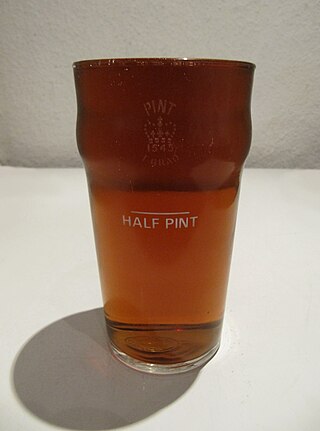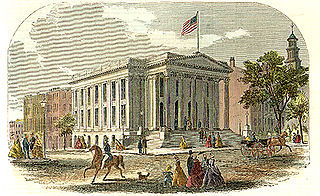Related Research Articles

The gallon is a unit of volume in British imperial units and United States customary units. Three different versions are in current use:

The imperial system of units, imperial system or imperial units is the system of units first defined in the British Weights and Measures Act 1824 and continued to be developed through a series of Weights and Measures Acts and amendments.

In recipes, quantities of ingredients may be specified by mass, by volume, or by count.

The pint is a unit of volume or capacity in both the imperial and United States customary measurement systems. In both of those systems it is traditionally one eighth of a gallon. The British imperial pint is about 20% larger than the American pint because the two systems are defined differently. Almost all other countries have standardized on the metric system, so although some of them still also have traditional units called pints, the volume varies by regional custom.

A bushel is an imperial and US customary unit of volume based upon an earlier measure of dry capacity. The old bushel is equal to 2 kennings (obsolete), 4 pecks, or 8 dry gallons, and was used mostly for agricultural products, such as wheat. In modern usage, the volume is nominal, with bushels denoting a mass defined differently for each commodity.

A barrel is one of several units of volume applied in various contexts; there are dry barrels, fluid barrels, oil barrels, and so forth. For historical reasons the volumes of some barrel units are roughly double the volumes of others; volumes in common use range approximately from 100 to 200 litres. In many connections the term drum is used almost interchangeably with barrel.

A barrel or cask is a hollow cylindrical container with a bulging center, longer than it is wide. They are traditionally made of wooden staves and bound by wooden or metal hoops. The word vat is often used for large containers for liquids, usually alcoholic beverages; a small barrel or cask is known as a keg.

A keg is a small cask used for storing liquids. Wooden kegs made by a cooper were used to transport nails, gunpowder, and a variety of liquids. Nowadays a keg is normally constructed of stainless steel, although aluminium can be used if it is coated with plastic on the inside. It is commonly used to store, transport, and serve beer. Other alcoholic or non-alcoholic drinks, carbonated or non-carbonated, may be housed in a keg as well. Carbonated drinks are generally kept under pressure in order to maintain carbon dioxide in solution, preventing the beverage from becoming flat.
The tun is an English unit of liquid volume, used for measuring wine, oil or honey. Typically a large vat or vessel, most often holding 252 wine gallons, but occasionally other sizes were also used. The modern tun is about 954 litres.
English units were the units of measurement used in England up to 1826, which evolved as a combination of the Anglo-Saxon and Roman systems of units. Various standards have applied to English units at different times, in different places, and for different applications.

Weights and Measures Acts are acts of the British Parliament determining the regulation of weights and measures. It also refers to similar royal and parliamentary acts of the Kingdoms of England and Scotland and the medieval Welsh states. The earliest of these were originally untitled but were given descriptive glosses or titles based upon the monarch under whose reign they were promulgated. Several omnibus modern acts have the short title "Weights and Measures Act" and are distinguished by the year of their enactment.
Winchester measure is a set of legal standards of volume instituted in the late 15th century (1495) by King Henry VII of England and in use, with some modifications, until the present day. It consists of the Winchester bushel and its dependent quantities, the peck, (dry) gallon and (dry) quart. They would later become known as the Winchester Standards, named because the examples were kept in the city of Winchester.
Capacities of wine casks were formerly measured and standardised according to a specific system of English units. The various units were historically defined in terms of the wine gallon so varied according to the definition of the gallon until the adoption of the Queen Anne wine gallon in 1707. In the United Kingdom and its colonies the units were redefined with the introduction of the imperial system whilst the Queen Anne wine gallon was adopted as the standard US liquid gallon.
A wine gallon is a unit of capacity that was used routinely in England as far back as the 14th century, and by statute under Queen Anne since 1707. Britain abandoned the wine gallon in 1826 when it adopted imperial units for measurement: the 1707 wine gallon is the basis of the United States' gallon, as well as other measures.
Capacities of brewery casks were formerly measured and standardised according to a specific system of English units. The system was originally based on the ale gallon of 282 cubic inches. In United Kingdom and its colonies, with the adoption of the imperial system in 1824, the units were redefined in terms of the slightly smaller imperial gallon. The older units continued in use in the United States.

The imperial and US customary measurement systems are both derived from an earlier English system of measurement which in turn can be traced back to Ancient Roman units of measurement, and Carolingian and Saxon units of measure.
The quarter was used as the name of several distinct English units based on ¼ sizes of some base unit.
Tub was a unit of capacity or of weight used in Britain and elsewhere.
A number of units of measurement were used in South Africa to measure quantities like length, mass, capacity, etc. The Imperial system of measurements was made standard in 1922 and the metric system was adopted in 1961.
The Exchequer Standards may refer to the set of official English standards for weights and measures created by Queen Elizabeth I, and in effect from 1588 to 1825, when the Imperial units system took effect, or to the whole range of English unit standards maintained by the Court of the Exchequer from the 1200s, or to the physical reference standards physically kept at the Exchequer and used as the legal reference until the such responsibility was transferred in the 1860s, after the Imperial system had been established.
References
- ↑ "Definition of firkin". www.dictionary.com. Retrieved 2021-01-08.
- ↑ "firkin" . Retrieved 2023-09-03.
- ↑ François Cardarelli (2003). Encyclopaedia of Scientific Units, Weights and Measures. Their SI Equivalences and Origins . London: Springer. p. 44. ISBN 978-1-44-711122-1.
- ↑ John Burroughs (1922). My Boyhood. Doubleday, Page & Co. pp. 17–22.
The packing into one-hundred-pound firkins to be held over till November did not begin till the cows were turned out to pasture in May. …the naked firkin of butter, sweating drops of salt water.
- ↑ Robinson, William (1825). The Magistrate's Pocket-book, Or, An Epitome of the Duties and Practice of a Justice of the Peace. C. Hunter. p. 50. Retrieved 9 April 2015.
- ↑ Crabb, George (1841). A Digest and Index with Chronological Tables of All the Statutes: From Magna Charta to the End of this Last. A. Maxwell & son. p. 231. Retrieved 9 April 2015.
- ↑ Rowlett, Russ. "How Many? A Dictionary of Units of Measurement". Archived from the original on 9 July 2018. Retrieved 9 April 2015.
- ↑ "Conversion Center". Archived from the original on 6 October 2022. Retrieved 26 November 2019.